The construction sector has increasingly embraced artificial intelligence, transforming traditional processes on the building site. AI’s impact on productivity and its potential effects on the future workforce are significant areas of focus.
There are three primary areas where AI is expected to bring substantial benefits within the construction site, with safety being paramount. AI can elevate workers’ wellbeing by scanning body movements to analyse whether their form is correct when working with tools and machinery, thereby preventing injuries and enhancing training. Scanning technology can also be employed for facial and object recognition to verify a worker’s qualifications, further reducing injury risks.
Risk mitigation is another essential aspect where AI plays a crucial role. By understanding and predicting complex information using built-in algorithms, AI can help prevent potential risks that might impact the building site or its workers. For instance, AI can alert site staff about adverse weather conditions, allowing them to address issues such as water infiltration before they arise.
AI also contributes significantly to the design process. The technology can generate multiple designs based on a client’s requirements much faster than traditional methods. By understanding client preferences such as optimal seating positions for sunlight and productivity, AI integrates this information with the building’s physical requirements. As a result, the algorithm produces several design options, enabling architects to select and further refine these designs according to the client’s wishes.
However, the future role of AI in construction presents notable challenges, particularly concerning the current workforce. Experts predict a human-free building site as early as 2025, due to the culmination of several technologies. By 2019, augmented reality and the Internet of Things are anticipated to become mainstream. Regulations permitting drone monitoring are expected by 2021. Self-guided machines will likely appear by 2022, and the first project managed solely by AI is projected by 2023. Autonomous machinery is expected onsite by 2024, leading to a sharp decline in the need for human workers by 2025, as machines will handle the majority of tasks.
Research suggests that the integration of AI could result in the loss of 600,000 jobs from the current 2.2 million positions by 2040. Labourers, plasterers, and roofers are among the most affected, with their numbers expected to fall drastically, highlighting a significant shift in the construction workforce landscape.
As AI continues to evolve within the construction sector, its contributions to safety, risk mitigation, and design efficiency are evident. However, the projected decline in human jobs underscores the need for strategic planning to address workforce displacement and ensure a balanced integration of technology.


